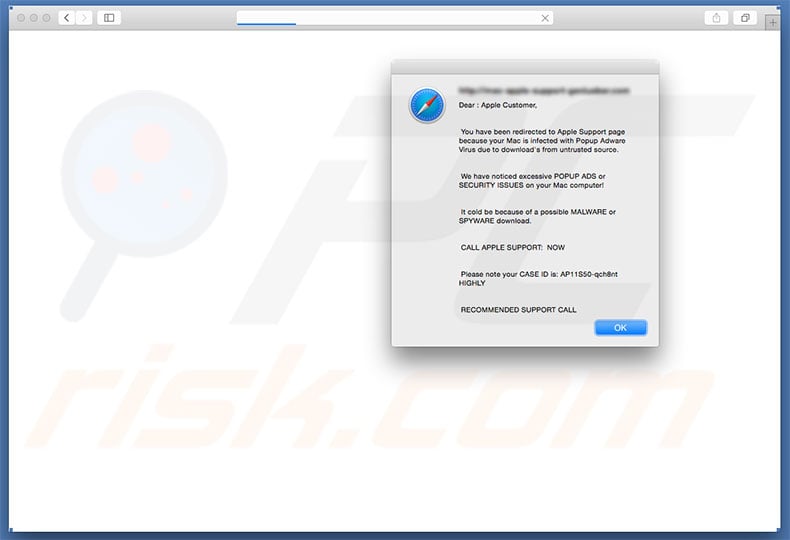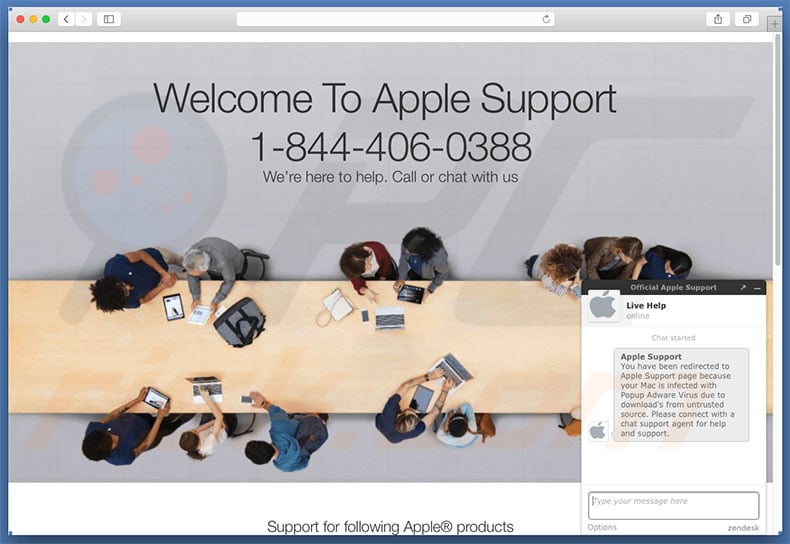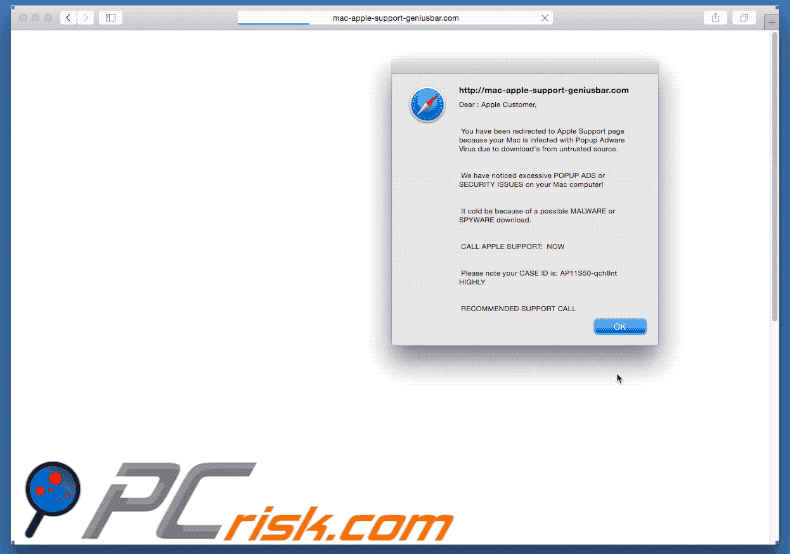Your Mac Is Infected With Popup Adware Virus Scam (Mac)
Mac VirusAlso Known As: "Your Mac Is Infected With Popup Adware Virus" virus
Get free scan and check if your device is infected.
Remove it nowTo use full-featured product, you have to purchase a license for Combo Cleaner. Seven days free trial available. Combo Cleaner is owned and operated by RCS LT, the parent company of PCRisk.com.
What is Your Mac Is Infected With Popup Adware Virus?
"Your Mac Is Infected With Popup Adware Virus" is another fake error similar to AppleCare And Warranty, WARNING! MAC OS Is Infected, Apple Support Center - Attention!!, and many others. This error message targets MacOS users and is displayed by a malicious website that users often visit inadvertently - they are redirected by potentially unwanted programs (PUPs).
Research shows that these programs infiltrate systems without users' consent, misuse system resources, deliver malicious ads, and record various user-system information.

This error claims to detect an excessive number of ads due to a possible computer infection: the malware must be eliminated immediately and, for this reason, users should contact Apple Technical Support via a telephone number ("1-844-406-0388") provided. Victims are then supposedly guided through the malware removal process.
Note is that this malicious website also contains a fake 'live chat', which supposedly allows users to access the same technical support service. In fact, "Your Mac Is Infected With Popup Adware Virus" is a scam. This error is fake and has nothing to do with Apple.
Cyber criminals aim to generate revenue by selling their services (that are not even needed, since the malware does not exist) to unsuspecting users. Furthermore, cyber criminals attempt to gain remote access to users' computers to change system settings and/or install malware. Criminals then claim to "detect" further issues and offer their help for an additional fee.
For these reasons, ignore the "Your Mac Is Infected With Popup Adware Virus" error and never attempt to call the aforementioned telephone number. This error can be removed simply by closing the web browser or restarting the system.
Be aware that some potentially unwanted programs and malicious websites significantly diminish system performance by misusing resources to mine cryptocurrency or run other unwanted processes without permission. With regard to potentially unwanted programs, they are likely to generate various 'malvertising' ads such as banners, pop-ups, coupons, and so on.
These are displayed using various tools that enable placement of third party graphical content on any site. Therefore, the displayed ads often conceal underlying website content, thereby significantly diminishing the web browsing experience.
In addition, 'malvertising' ads typically lead to malicious websites and, in some cases, execute scripts that download and install malware or other potentially unwanted programs. Thus, clicking them can cause high-risk computer infections. In addition, potentially unwanted programs continually record information that often includes private details.
This information is sold to third parties (mostly, for marketing purposes). These actions are performed only to generate revenue. For these reasons, potentially unwanted programs must be uninstalled immediately.
| Name | "Your Mac Is Infected With Popup Adware Virus" virus |
| Threat Type | Mac malware, Mac virus |
| Cyber Criminals' Phone Number | +1-866-746-1075 |
| Symptoms | Your Mac became slower than normal, you see unwanted pop-up ads, you get redirected to shady websites. |
| Distribution methods | Deceptive pop-up ads, free software installers (bundling), fake flash player installers, torrent file downloads. |
| Damage | Internet browsing tracking (potential privacy issues), displaying of unwanted ads, redirects to shady websites, loss of private information. |
| Malware Removal (Windows) |
To eliminate possible malware infections, scan your computer with legitimate antivirus software. Our security researchers recommend using Combo Cleaner. Download Combo CleanerTo use full-featured product, you have to purchase a license for Combo Cleaner. 7 days free trial available. Combo Cleaner is owned and operated by RCS LT, the parent company of PCRisk.com. |
As mentioned above, "Your Mac Is Infected With Popup Adware Virus" shares many similarities with dozens of other fake errors. All claim that the system is infected, missing files, or damaged in other similar ways, however, these claims are merely attempts to scare and trick victims into calling and paying for technical services that are not required.
All potentially unwanted programs are very similar. By offering various useful features, these programs attempt to give the impression of legitimacy, however, their only purpose is to generate revenue for the developers. Rather than providing any real value for regular users, PUPs pose a direct threat to your privacy and Internet browsing safety.
How did potentially unwanted programs install on my computer?
Cyber criminals proliferate potentially unwanted programs via the aforementioned malicious ads, together with a deceptive marketing method called "bundling". Therefore, due to poor knowledge and careless behavior by many users, PUPs often infiltrate systems without permission.
"Bundling" is stealth installation of third party programs together with regular software/apps. Developers conceal "bundled" apps within various sections (usually the "Custom/Advanced" settings) - they do not adequately disclose this information.
Many users rush the download/installation processes, skip steps, and click various ads. In doing so, they expose their systems to risk of various infections.
How to avoid installation of potentially unwanted applications?
To prevent this situation, be very cautious when downloading/installing software and browsing the Internet. Carefully analyze each step of the download/installation processes to opt-out of all additionally-included programs. Avoid using third party download/installation tools, since they are monetized by promoting dubious apps (the "bundling" method).
Furthermore, many malicious ads appear genuine, however, they are distinguishable for their redirects - most lead to gambling, adult dating, pornography, and other dubious websites. If you encounter them, immediately eliminate all suspicious apps/browser plug-ins.
Text presented in the "Your Mac Is Infected With Popup Adware Virus" pop-up and the live chat:
Apple Support
You have been redirected to Apple Support page because your Mac is infected with Popup Adware Virus due to download's from untrusted source. Please connect with a chat support agent for help and support.
Website displaying "Your Mac Is Infected With Popup Adware Virus" error:

Text presented within this site:
Welcome To Apple Support
1-844-406-0388
We’re here to help. Call or chat with us
Contact Expert Support
How can we help you?
Get support by phone, chat, or email, set up a repair, or make a Genius Bar appointment.
Call 1-844-406-0388 or Chat With Us
Appearance of "Your Mac Is Infected With Popup Adware Virus" scam (GIF):

Instant automatic malware removal:
Manual threat removal might be a lengthy and complicated process that requires advanced IT skills. Combo Cleaner is a professional automatic malware removal tool that is recommended to get rid of malware. Download it by clicking the button below:
DOWNLOAD Combo CleanerBy downloading any software listed on this website you agree to our Privacy Policy and Terms of Use. To use full-featured product, you have to purchase a license for Combo Cleaner. 7 days free trial available. Combo Cleaner is owned and operated by RCS LT, the parent company of PCRisk.com.
Quick menu:
- What is Your Mac Is Infected With Popup Adware Virus?
- STEP 1. Remove PUP related files and folders from OSX.
- STEP 2. Remove rogue extensions from Safari.
- STEP 3. Remove rogue add-ons from Google Chrome.
- STEP 4. Remove potentially unwanted plug-ins from Mozilla Firefox.
Video showing how to remove rogue applications that deliver "Your Mac Is Infected With Popup Adware Virus" pop-up using Combo Cleaner:
Potentially unwanted programs removal:
Remove PUP-related potentially unwanted applications from your "Applications" folder:

Click the Finder icon. In the Finder window, select “Applications”. In the applications folder, look for “MPlayerX”,“NicePlayer”, or other suspicious applications and drag them to the Trash. After removing the potentially unwanted application(s) that cause online ads, scan your Mac for any remaining unwanted components.
DOWNLOAD remover for malware infections
Combo Cleaner checks if your computer is infected with malware. To use full-featured product, you have to purchase a license for Combo Cleaner. 7 days free trial available. Combo Cleaner is owned and operated by RCS LT, the parent company of PCRisk.com.
Remove adware-related files and folders

Click the Finder icon, from the menu bar. Choose Go, and click Go to Folder...
 Check for adware generated files in the /Library/LaunchAgents/ folder:
Check for adware generated files in the /Library/LaunchAgents/ folder:

In the Go to Folder... bar, type: /Library/LaunchAgents/

In the "LaunchAgents" folder, look for any recently-added suspicious files and move them to the Trash. Examples of files generated by adware - "installmac.AppRemoval.plist", "myppes.download.plist", "mykotlerino.ltvbit.plist", "kuklorest.update.plist", etc. Adware commonly installs several files with the exact same string.
 Check for adware generated files in the ~/Library/Application Support/ folder:
Check for adware generated files in the ~/Library/Application Support/ folder:

In the Go to Folder... bar, type: ~/Library/Application Support/

In the "Application Support" folder, look for any recently-added suspicious folders. For example, "MplayerX" or "NicePlayer", and move these folders to the Trash.
 Check for adware generated files in the ~/Library/LaunchAgents/ folder:
Check for adware generated files in the ~/Library/LaunchAgents/ folder:

In the Go to Folder... bar, type: ~/Library/LaunchAgents/

In the "LaunchAgents" folder, look for any recently-added suspicious files and move them to the Trash. Examples of files generated by adware - "installmac.AppRemoval.plist", "myppes.download.plist", "mykotlerino.ltvbit.plist", "kuklorest.update.plist", etc. Adware commonly installs several files with the exact same string.
 Check for adware generated files in the /Library/LaunchDaemons/ folder:
Check for adware generated files in the /Library/LaunchDaemons/ folder:

In the "Go to Folder..." bar, type: /Library/LaunchDaemons/

In the "LaunchDaemons" folder, look for recently-added suspicious files. For example "com.aoudad.net-preferences.plist", "com.myppes.net-preferences.plist", "com.kuklorest.net-preferences.plist", "com.avickUpd.plist", etc., and move them to the Trash.
 Scan your Mac with Combo Cleaner:
Scan your Mac with Combo Cleaner:
If you have followed all the steps correctly, your Mac should be clean of infections. To ensure your system is not infected, run a scan with Combo Cleaner Antivirus. Download it HERE. After downloading the file, double click combocleaner.dmg installer. In the opened window, drag and drop the Combo Cleaner icon on top of the Applications icon. Now open your launchpad and click on the Combo Cleaner icon. Wait until Combo Cleaner updates its virus definition database and click the "Start Combo Scan" button.

Combo Cleaner will scan your Mac for malware infections. If the antivirus scan displays "no threats found" - this means that you can continue with the removal guide; otherwise, it's recommended to remove any found infections before continuing.

After removing files and folders generated by the adware, continue to remove rogue extensions from your Internet browsers.
Remove malicious extensions from Internet browsers
 Remove malicious Safari extensions:
Remove malicious Safari extensions:

Open the Safari browser, from the menu bar, select "Safari" and click "Preferences...".

In the preferences window, select "Extensions" and look for any recently-installed suspicious extensions. When located, click the "Uninstall" button next to it/them. Note that you can safely uninstall all extensions from your Safari browser - none are crucial for regular browser operation.
- If you continue to have problems with browser redirects and unwanted advertisements - Reset Safari.
 Remove malicious extensions from Google Chrome:
Remove malicious extensions from Google Chrome:

Click the Chrome menu icon ![]() (at the top right corner of Google Chrome), select "More Tools" and click "Extensions". Locate all recently-installed suspicious extensions, select these entries and click "Remove".
(at the top right corner of Google Chrome), select "More Tools" and click "Extensions". Locate all recently-installed suspicious extensions, select these entries and click "Remove".

- If you continue to have problems with browser redirects and unwanted advertisements - Reset Google Chrome.
 Remove malicious extensions from Mozilla Firefox:
Remove malicious extensions from Mozilla Firefox:

Click the Firefox menu ![]() (at the top right corner of the main window) and select "Add-ons and themes". Click "Extensions", in the opened window locate all recently-installed suspicious extensions, click on the three dots and then click "Remove".
(at the top right corner of the main window) and select "Add-ons and themes". Click "Extensions", in the opened window locate all recently-installed suspicious extensions, click on the three dots and then click "Remove".

- If you continue to have problems with browser redirects and unwanted advertisements - Reset Mozilla Firefox.
Share:

Tomas Meskauskas
Expert security researcher, professional malware analyst
I am passionate about computer security and technology. I have an experience of over 10 years working in various companies related to computer technical issue solving and Internet security. I have been working as an author and editor for pcrisk.com since 2010. Follow me on Twitter and LinkedIn to stay informed about the latest online security threats.
PCrisk security portal is brought by a company RCS LT.
Joined forces of security researchers help educate computer users about the latest online security threats. More information about the company RCS LT.
Our malware removal guides are free. However, if you want to support us you can send us a donation.
DonatePCrisk security portal is brought by a company RCS LT.
Joined forces of security researchers help educate computer users about the latest online security threats. More information about the company RCS LT.
Our malware removal guides are free. However, if you want to support us you can send us a donation.
Donate
▼ Show Discussion